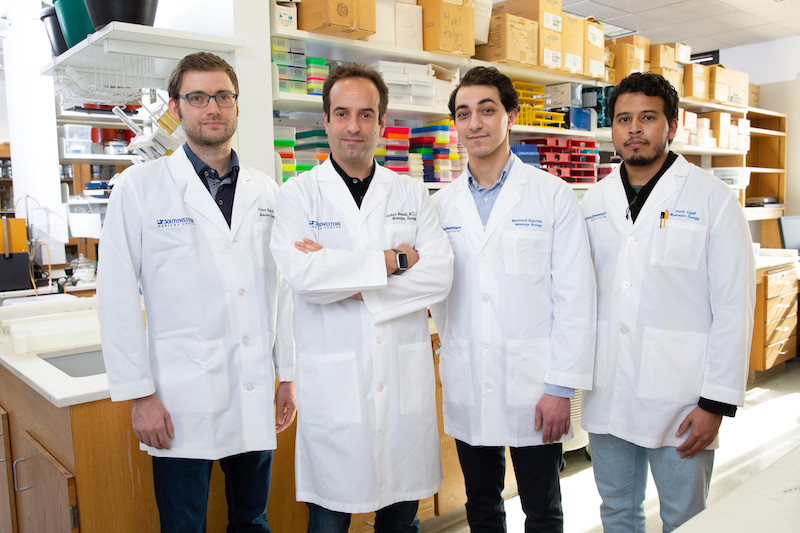A new genetic pathway that prevents early aging

DALLAS – March 8, 2019 – Building upon their earlier discoveries, researchers at UT Southwestern have identified a new genetic pathway that prevents premature aging.
Published in eLife, the study investigated the activity of the gene NORAD, a long noncoding ribonucleic acid, or RNA. NORAD, which stands for Noncoding RNA Activated by DNA Damage, is present in many mammals and helps maintain the appropriate number of chromosomes as cells divide.
Many RNAs in the cell serve as the instructions, or code, for building proteins, whereas noncoding RNAs do not encode proteins. “There are many questions in the scientific community regarding the importance of noncoding RNAs in mammalian physiology and development,” said Dr. Joshua T. Mendell, Professor of Molecular Biology at UT Southwestern and senior author of the study. “Our cells produce thousands of these RNAs, but only a few have been connected to important functions in animals.”
In 2015, the researchers reported their discovery of NORAD and demonstrated the importance of this noncoding RNA in maintaining the correct number of chromosomes in human cells. With their previous work limited to cells grown in the laboratory, the researchers next examined the role of NORAD in a living animal, in order to better understand the gene’s function in mammalian physiology. To accomplish this, Dr. Florian Kopp, a postdoctoral researcher in the Mendell lab and lead author of the eLife study, genetically engineered mice by deleting NORAD from the genome.
As was found in human cells, the loss of NORAD caused chromosomal defects in mice. But there were also some unexpected changes to mitochondria, the energy powerhouses of the cell.
“We were surprised to see that when NORAD was removed, mitochondrial function became very abnormal. These mice also appeared to age very rapidly,” said Dr. Mendell, a Howard Hughes Medical Institute (HHMI) Investigator, Cancer Prevention and Research Institute of Texas (CPRIT) Scholar in Cancer Research, and member of both the Hamon Center for Regenerative Science and Medicine and the Harold C. Simmons Comprehensive Cancer Center.
“We found that NORAD is critical for the proper regulation of two distinct processes – genome stability and mitochondrial function – both of which have been linked to aging. As a result of the defects in these processes, loss of this RNA results in a very dramatic premature aging phenotype,” he added.
NORAD functions by binding to the protein Pumilio, Dr. Kopp explained.
“The normal function of Pumilio is to decrease the levels of hundreds of other proteins in the cell. NORAD acts as an inhibitor of Pumilio,” he explained. “When NORAD is lost, Pumilio becomes overactive and reduces the levels of many proteins that participate in chromosome segregation during cell division and mitochondrial activity. Thus, NORAD acts as a critical guardian of the genome and mitochondrial homeostasis by restraining Pumilio activity.”
The researchers said there are some intriguing hints that regulation of NORAD or Pumilio plays a role in natural aging. For example, lower levels of NORAD and higher levels of Pumilio have been found in older people.
“We need to better understand how this pathway – NORAD and its target Pumilio – are controlled in normal physiologic settings and in aging. If disruption of this pathway is part of the aging process, then it will be important to understand the mechanisms through which this disruption occurs. Eventually, this research could lead to an ability to prevent or reverse the aging process,” Dr. Mendell said.
“Another important line of investigation relates to whether NORAD is altered in any diseases – particularly premature aging syndromes known as progerias,” he added.
Additional UT Southwestern researchers involved in the study are Mahmoud M. Elguindy, a graduate student researcher in the Medical Scientist Training Program; Dr. He Zhang, a Computational Biologist in the Bioinformatics Core Facility; Frank A. Gillett, a Research Technician in the Mendell lab; Dr. Hongtao Yu, Professor of Pharmacology and an HHMI Investigator; Dr. Sushama Sivakumar, a postdoctoral fellow in the Yu lab; Dr. Yang Xie, Associate Professor of Population and Data Sciences and Bioinformatics; and Dr. Prashant Mishra, an Assistant Professor in the Children’s Medical Center Research Institute at UT Southwestern, in the Cecil H. and Ida Green Comprehensive Center for Molecular, Computational, and Systems Biology, and of Pediatrics. Dr. Yu, a Michael L. Rosenberg Scholar in Medical Research, also holds The Serena S. Simmons Distinguished Chair in Cancer Immunopharmacology at UTSW. Also contributing to this work were Dr. Zarife Sahenk at Nationwide Children’s Hospital, Dr. Sungyul Lee at Seoul National University, and Dr. Mehmet Yalvac at The Ohio State University.
The research was supported by grants from CPRIT, the National Institutes of Health (NIH), HHMI, The Welch Foundation, and the Leopoldina Fellowship Program of the German National Academy of Sciences Leopoldina.
About UT Southwestern Medical Center
UT Southwestern, one of the premier academic medical centers in the nation, integrates pioneering biomedical research with exceptional clinical care and education. The institution’s faculty has received six Nobel Prizes, and includes 22 members of the National Academy of Sciences, 17 members of the National Academy of Medicine, and 15 Howard Hughes Medical Institute Investigators. The full-time faculty of more than 2,500 is responsible for groundbreaking medical advances and is committed to translating science-driven research quickly to new clinical treatments. UT Southwestern physicians provide care in about 80 specialties to more than 105,000 hospitalized patients, nearly 370,000 emergency room cases, and oversee approximately 3 million outpatient visits a year.
